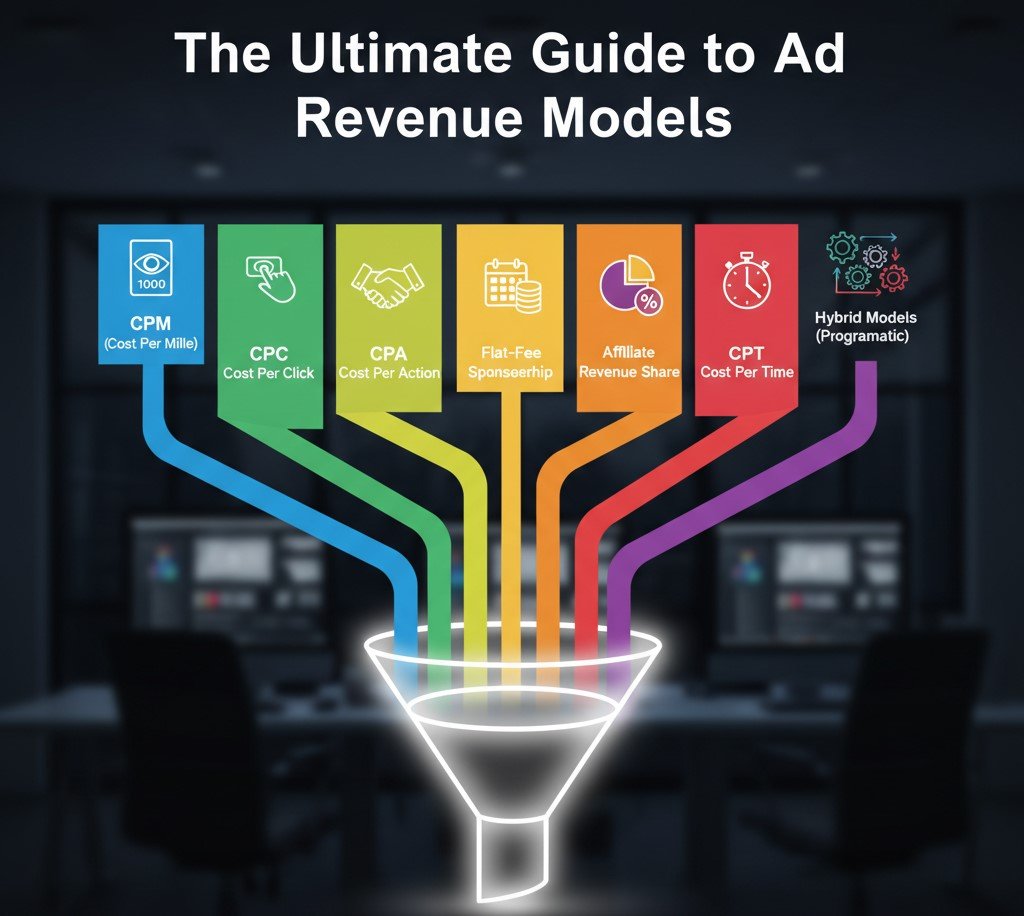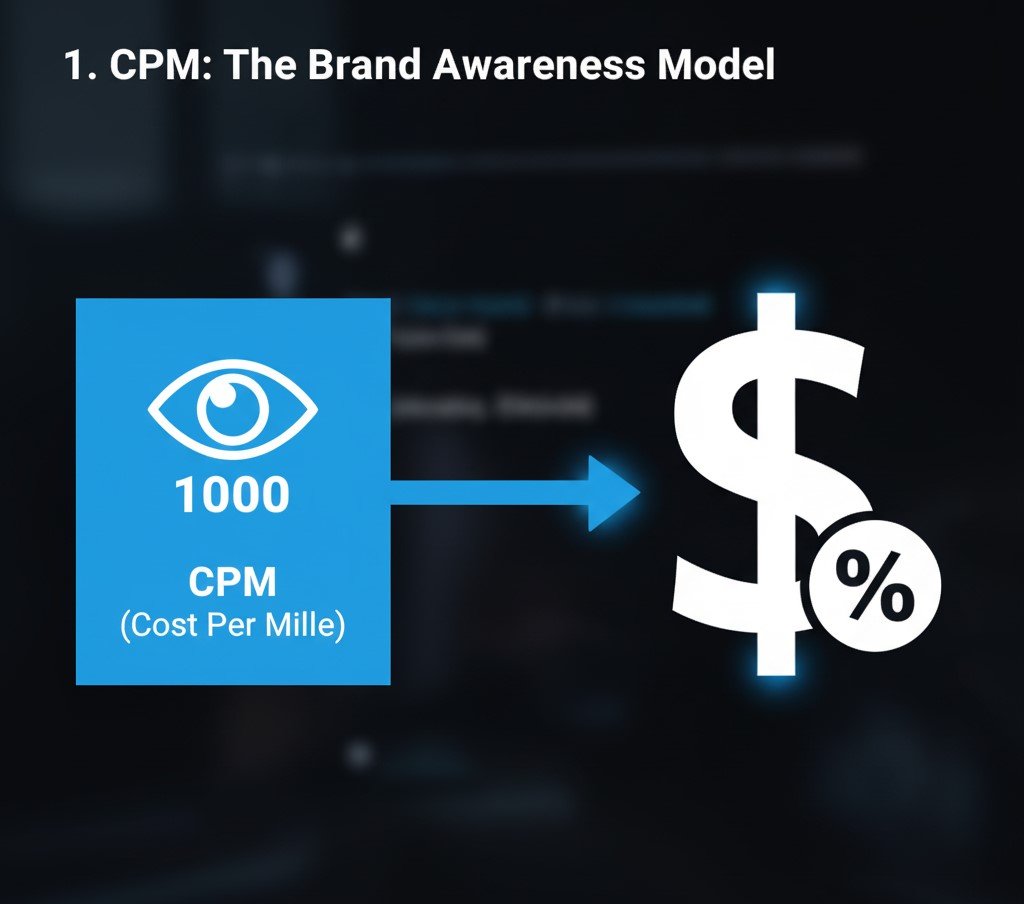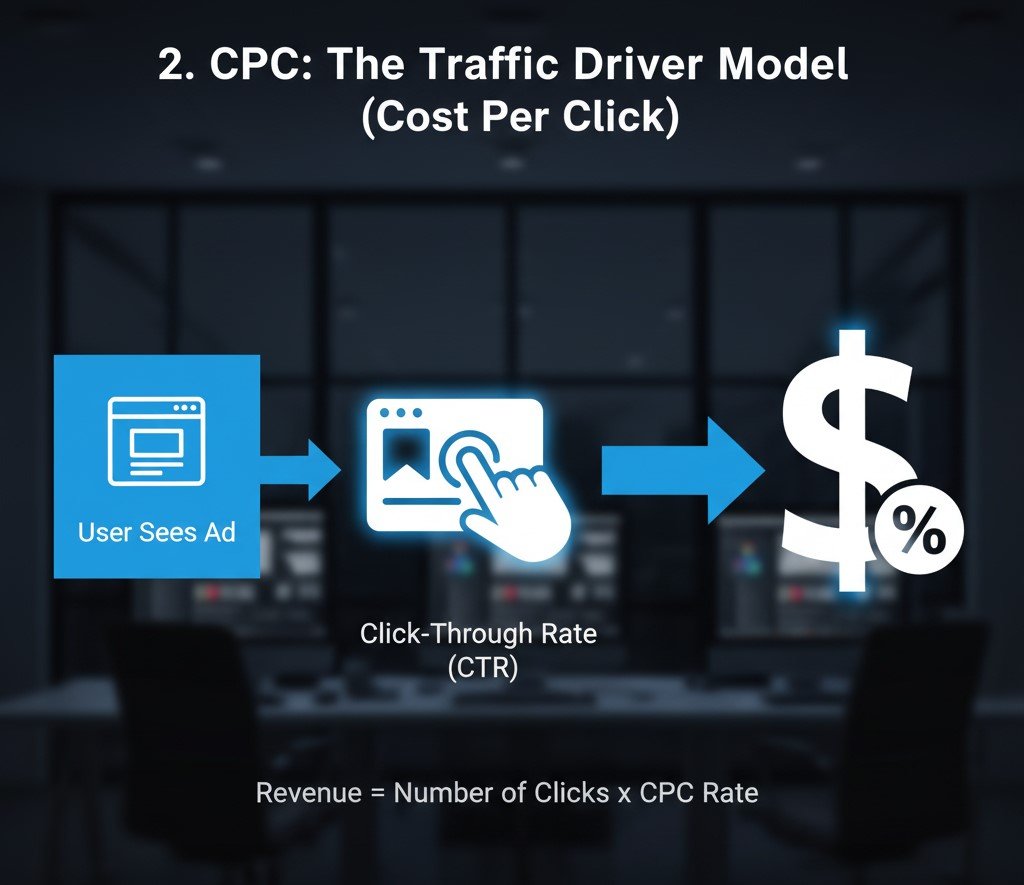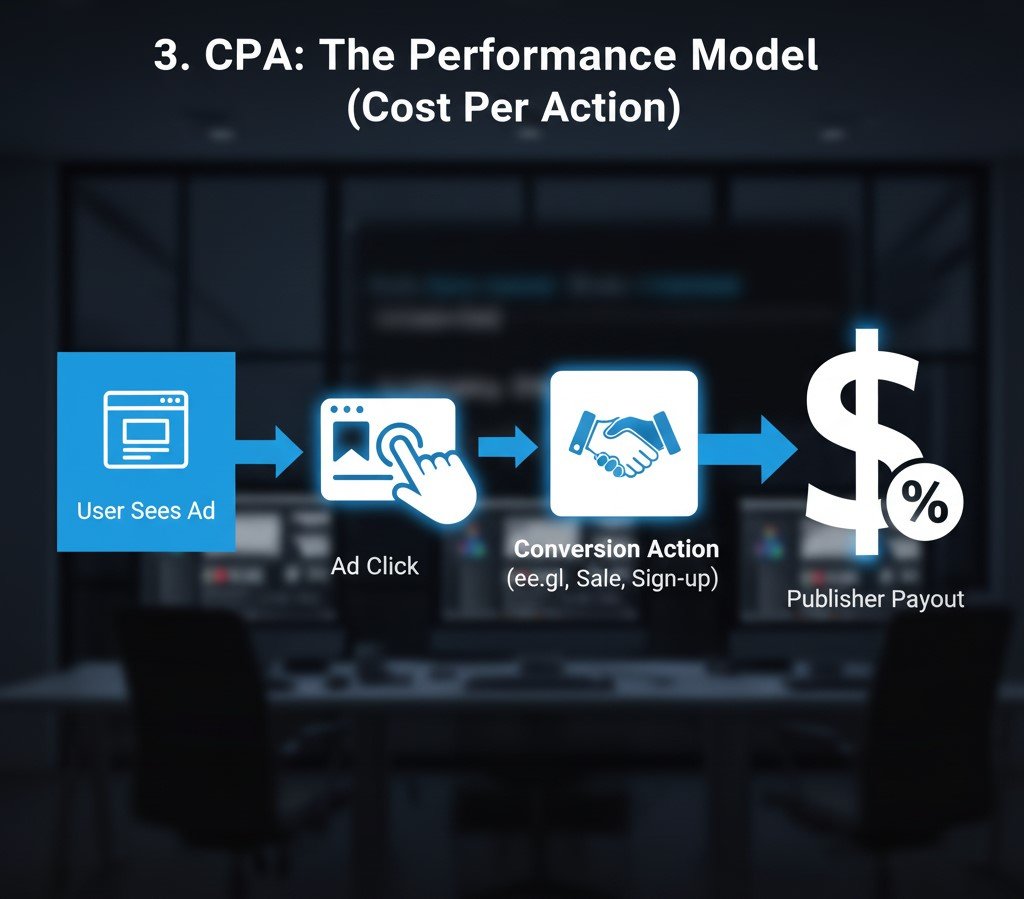Ever wondered how some websites seem to effortlessly rake in cash from ads, while others struggle to make a dime? The secret often lies in understanding and strategically implementing different ad revenue models. It’s not just about slapping a few ads on your site; it’s about choosing the right monetization strategy that aligns with your traffic, content, and audience.
Whether you’re a budding blogger, an established content creator, or a digital publisher looking to optimize your earnings, this guide will demystify the world of online advertising revenue. We’ll break down the 7 main ad revenue models for blogs and websites, from the foundational “Big Three” (CPM, CPC, CPA) to more advanced, high-value options. By the end, you’ll have a clear roadmap to selecting the best ad revenue model for a website like yours, turning your digital real estate into a powerful income generator.
Ready to unlock your website’s full earning potential? Let’s dive in!
Why Understanding Your Ad Revenue Model is Essential for Growth
Think of your website as a business. Just like any business, you need a clear strategy to generate income. An ad revenue model is simply the method by which you get paid for displaying ads. Without understanding these models, you’re essentially leaving money on the table.
Knowing the different types allows you to:
- Set Measurable Income Goals: Understand how various metrics (like impressions or clicks) translate directly into earnings.
- Optimize Ad Inventory: Place ads effectively where they’ll generate the most value based on your chosen model.
- Maximize eCPM: Compare different ad types fairly to see what genuinely brings in the most effective revenue per thousand impressions.
- Diversify Revenue Streams: Relying on just one model can be risky. A mix offers stability and higher overall earnings.
In short, a solid grasp of digital advertising metrics and publisher monetization strategies is the bedrock of successful online monetization.

The Big Three: Core Advertising Models Explained
These three models form the foundation of almost all online advertising revenue streams. You’ll encounter them constantly, and understanding their nuances is key to selecting the best fit for your content.
1. CPM: The Brand Awareness Model (Cost Per Mille)
CPM, or Cost Per Mille (where “Mille” is Latin for thousand), is arguably the most common and straightforward ad revenue model. With CPM, you get paid for every 1,000 times an ad is displayed on your website, regardless of whether a user interacts with it. This makes it ideal for advertisers focused on brand awareness and reach.
How it Works:
- Payout Trigger: Impressions (ad views).
- Calculation: Your earnings are calculated using the formula: Revenue=(Impressions×CPM)/1000.
- Best For: Websites with high traffic volume but perhaps lower engagement per visitor. News sites, large blogs, and forums often leverage CPM effectively.
Pros for Publishers: Consistent income (if traffic is steady), relatively low effort once ads are placed.
Cons for Publishers: Lower payout per impression compared to other models, susceptible to ad blockers.
Understanding cost per thousand impressions is fundamental for any publisher managing display ads.

2. CPC: The Traffic Driver Model (Cost Per Click)
CPC, or Cost Per Click, is a performance-based model where you earn revenue each time a visitor clicks on an ad displayed on your site. This model is favored by advertisers who want to drive traffic directly to their own websites or landing pages.
How it Works:
- Payout Trigger: Clicks on the ad.
- Key Metric: Click-Through Rate (CTR) – the percentage of users who see an ad and click it. A higher CTR means more clicks and thus more revenue.
- Best For: Content that naturally encourages clicks or caters to audiences actively seeking information or products (e.g., product reviews, comparison articles, buying guides).
Pros for Publishers: Potentially higher earnings per interaction than CPM if your audience is engaged; rewards relevant ad placement.
Cons for Publishers: Requires active user engagement; lower traffic sites may struggle to generate significant clicks.
For those understanding ad revenue share vs flat fee, CPC falls into the share category, as your earnings directly correlate with user actions. If you’re comparing CPM vs CPC vs CPA for publishers, CPC offers a middle ground in terms of effort and reward.

3. CPA: The Performance Model (Cost Per Action/Acquisition)
CPA, or Cost Per Action (sometimes Cost Per Acquisition), is the ultimate performance-driven model. With CPA, you only get paid when a user completes a specific, pre-defined action after clicking an ad on your site. This action could be anything from filling out a form (CPL – Cost Per Lead) to making a purchase (CPS – Cost Per Sale) or downloading an app.
How it Works:
- Payout Trigger: A completed action (sale, lead, download, sign-up).
- Best For: Publishers with highly engaged, niche audiences that are predisposed to convert. Often used in affiliate marketing and lead generation. This model generally offers the highest payout per successful action.
Pros for Publishers: Very high potential earnings per conversion; rewards highly relevant content and targeted audiences.
Cons for Publishers: High risk – no payment without a conversion; requires strong content and a highly optimized user journey.
When comparing CPM vs CPC vs CPA for publishers, CPA stands out for its potential but also its demand for quality traffic that converts.

Beyond the Basics: 4 More High-Value Revenue Models
To maximize your revenue diversification and secure higher payouts, you shouldn’t limit yourself to just the Big Three. Established publishers often layer in these models to generate premium income and secure predictable cash flow.
4. Flat-Fee or Sponsorship Model
This model takes the guesswork out of impressions and clicks. A Flat-Fee model is simply a fixed, negotiated price an advertiser pays you for a dedicated ad slot or placement over a set period (e.g., a banner ad on the homepage for one month, or a mention in your weekly newsletter for six weeks).
How it Works:
- Payout Trigger: Time (monthly, weekly) or Fixed Placement. Performance metrics like CPM and CPC are irrelevant to the payment.
- Best For: Publishers with a highly specific, niche audience that advertisers are desperate to reach. Think industry-specific newsletters or blogs with a strong, loyal community.
- Pro Tip: This is a classic example of digital publisher revenue from direct sales, which typically commands much higher rates than programmatic advertising.
5. Affiliate Revenue Share (RevShare)
Often considered a form of CPA, the Affiliate Revenue Share model earns you a percentage of the actual money an advertiser makes from a sale. This is a common and powerful monetization strategy for review sites and product comparison blogs.
How it Works:
- Payout Trigger: A percentage of a completed transaction value. The user not only has to click (like CPC) and convert (like CPA), but also their purchase amount determines your payout.
- Key Metric: Commission Rate and Average Order Value (AOV).
- Best For: Content where you genuinely recommend products or services, like gadget reviews, fitness plans, or software tutorials.
6. CPT (Cost Per Time)
The CPT model is closely related to the Flat-Fee model but is often used in a programmatic context or for high-impact inventory. The advertiser essentially buys time on your entire webpage or a specific slot, guaranteeing their ad is displayed for a fixed duration, like a day or a week.
How it Works:
- Payout Trigger: The purchase of a time block.
- Best For: High-impact, site-takeover placements or specialized ad formats that guarantee maximum viewability for a short period. It’s a great way to generate guaranteed, short-term income.
7. Hybrid Models (Programmatic)
The reality for most successful large-scale publishers is that they don’t stick to just one model; they use them all simultaneously through programmatic advertising and header bidding. A Hybrid Model is a strategy that leverages technology to pit advertisers using different models against each other in real-time.
How it Works:
- Payout Trigger: Highest real-time bid.
- Example: When a user lands on your page, a CPM bidder might offer $5, while a CPC bidder’s predicted click value equates to $4, and a CPA bidder’s predicted conversion value equates to $6. The programmatic system automatically picks the highest predicted revenue (in this case, the CPA ad) to serve in milliseconds.
- Best For: Experienced publishers with significant traffic volume looking for maximum yield. This is the cutting edge of digital advertising models.
How to Choose the Right Ad Model for Your Website
Choosing the right mix of types of ad monetization comes down to balancing two key factors: your traffic volume and your audience’s intent. You can’t optimize what you don’t measure.
Traffic Quality vs. Traffic Volume
This is the most critical distinction for any publisher.
| Strategy | Audience Profile | Ideal Ad Model | Why It Works |
| High Volume, Low Intent | News readers, entertainment sites, general content. Users are browsing, not ready to buy. | CPM (Cost Per Mille) | You get paid for pure reach. You have enough views to make low CPM rates profitable. |
| Low Volume, High Intent | Niche product review sites, B2B services, educational guides. Users are researching before a purchase. | CPA (Cost Per Action) / Affiliate | Your limited traffic is valuable because it’s highly likely to convert, justifying high CPA rates. |
| Balanced Traffic | Established blogs with guides and tutorials. Users click on relevant internal links and ads. | CPC (Cost Per Click) / Hybrid | You have enough clicks to make CPC worthwhile, but enough volume to run standard display ads alongside it. |
A publisher trying to monetize a site with low traffic volume using only CPM is going to be disappointed. Instead, they should focus on CPA through affiliate programs, which offer a higher reward for their high-quality, targeted audience.
Key Metrics: Calculating Your True Revenue
To truly compare the performance of your different ad revenue models—CPM, CPC, CPA, and the rest—you need one universal metric that tells you how much revenue you’re actually earning per user: eCPM.
eCPM: The Universal Comparison Metric
eCPM, or Effective Cost Per Mille, is the metric publishers use to normalize and compare earnings across all ad types.
It measures your total revenue generated from 1,000 impressions, regardless of whether that revenue came from a click, a sale, or a flat fee. It’s the metric that finally allows you to answer the question: “Is this CPA ad placement actually more profitable than that CPM banner?”
The eCPM Formula:
eCPM=Total ImpressionsTotal Revenue×1,000
A high eCPM signifies a healthy, highly profitable ad strategy. If you’re looking for an instant ad revenue calculator to test your current figures, tools like the one on AdRevHub are perfect for modeling how changes in traffic or ad rates impact your potential website ad earnings.
Optimization Strategies to Maximize Earnings (Regardless of Model)
Once you’ve chosen your models, your focus shifts to maximizing their performance. Here are three universal tips for increasing your revenue.
- Prioritize Viewability: An ad must be seen to be counted as a valuable impression. Always place ads in highly viewable positions (like sticky sidebars or immediately after your introduction). Ads that load faster and stay above the fold command higher CPM rates.
- Focus on Site Speed: Ad networks and advertisers pay more for inventory on fast-loading websites. Why? Because slow loading affects Core Web Vitals, leading to a bad user experience and reduced ad viewability. Optimize your images and defer ad loading to improve speed.
- Use a Header Bidding Wrapper: For advanced users, implementing a header bidding solution is the single best way to maximize eCPM. It runs a real-time, simultaneous auction among multiple ad networks before the page content loads, ensuring you always get the highest bid for every impression.
Frequently Asked Questions About Ad Revenue Models
What is the most common ad revenue model for display advertising?
The most common model for display advertising is CPM (Cost Per Mille), which compensates publishers based on every 1,000 times an ad is successfully displayed to a user.
Is CPA or CPC more profitable for a publisher?
CPA (Cost Per Action) offers the highest potential reward per successful action, making it more profitable for conversion-focused, niche websites. However, CPC (Cost Per Click) is generally a more consistent and predictable revenue stream for most publishers with decent engagement.
How do hybrid ad models improve revenue?
Hybrid models, typically managed by programmatic platforms, improve revenue by allowing publishers to sell their ad inventory to the highest bidder in real-time, whether that bid is based on a CPM, CPC, or CPV (Cost Per View) rate. This approach maximizes the effective eCPM for every single impression.
What are the key factors that determine my ad revenue?
The four key factors that determine ad revenue are Traffic Volume (monthly visitors), Engagement (pageviews per visitor), Ad Density (ads per page), and Average CPM/Rate (the price advertisers are willing to pay for your audience).
Conclusion: Stop Guessing, Start Strategizing
Switching from a single, generic ad model to a well-planned, diversified revenue model can be the defining moment for your website’s financial success.
Whether you choose the stability of CPM for your high traffic, the precision of CPA for your niche audience, or a complex Hybrid approach, the key is to be deliberate. Start by calculating your baseline eCPM, experiment with ad formats, and use data-driven insights to guide your decisions. Stop leaving money on the table. By understanding ad revenue models for beginners and experts alike, you gain the power to turn your great content into a reliable, scalable income stream.